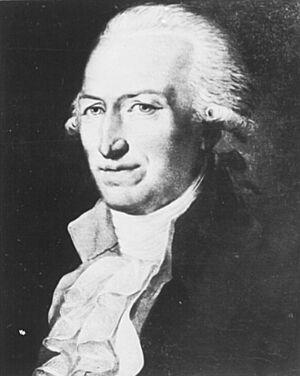Johann Joachim Eschenburg facts for kids
Johann Joachim Eschenburg (born December 7, 1743 – died February 29, 1820) was an important German writer. He was known as a critic and a historian of literature. This means he wrote about books and their authors, and he also studied how literature changed over time.
Contents
Early Life and Education
Johann Joachim Eschenburg was born in Hamburg, Germany. He also went to school there. Later, he studied at two famous universities: the University of Leipzig and the University of Göttingen.
In 1767, he started working at the Collegium Carolinum in Braunschweig. This school is now called TU Braunschweig. He began as a tutor, which is like a private teacher. After some time, he became a professor there. In 1786, he received the special title of Hofrat. Later, in 1814, he became one of the directors of the Carolinum.
Sharing English Literature
Eschenburg is most famous for helping Germans discover English literature. He worked hard to make English writers popular in Germany.
He translated many important English books into German. These books were often about aesthetics, which is the study of beauty and art. Some of the English writers he translated included Charles Burney, Joseph Priestley, and Richard Hurd.
Shakespeare's Plays in German
One of his biggest achievements was translating all of Shakespeare's plays into German prose. This means he translated them into regular spoken language, not poetry. His translation was called William Shakespear's Schauspiele. It came out in 13 volumes between 1775 and 1782.
Before Eschenburg, another writer named Christoph Martin Wieland had started translating Shakespeare. But Wieland's translation was not finished. Eschenburg's work was like a new and complete version of Wieland's earlier efforts.
Other Writings and Poetry
Besides his translations, Eschenburg also edited the works of other German poets. These included Friedrich von Hagedorn and Zachariä.
He also wrote many of his own books. Some of his well-known works include:
- Handbuch der klassischen Literatur (1783) – A guide to classic literature.
- Entwurf einer Theorie und Literatur der schönen Wissenschaften (1783) – Ideas about the theory and literature of fine arts.
- Beispielsammiung zur Theorie und Literatur der schönen Wissenschaften (1788–1795) – A collection of examples for the theory and literature of fine arts.
- Lehrbuch der Wissenschaftskunde (1792) – A textbook on the study of knowledge.
- Denkmäler altdeutscher Dichtkunst (1799) – Monuments of old German poetry.
Many of these books were very popular and were printed many times.
Eschenburg was also a poet himself. Some of his hymns, which are religious songs, are still known today. Two examples are Ich will dich noch im Tod erheben and Dir trau ich, Gott, und wanke nicht.
Recognition
In 1809, Eschenburg became a correspondent for the Royal Institute of the Netherlands. This meant he was a member who lived in another country. In 1818, he became an associated member of the institute.


